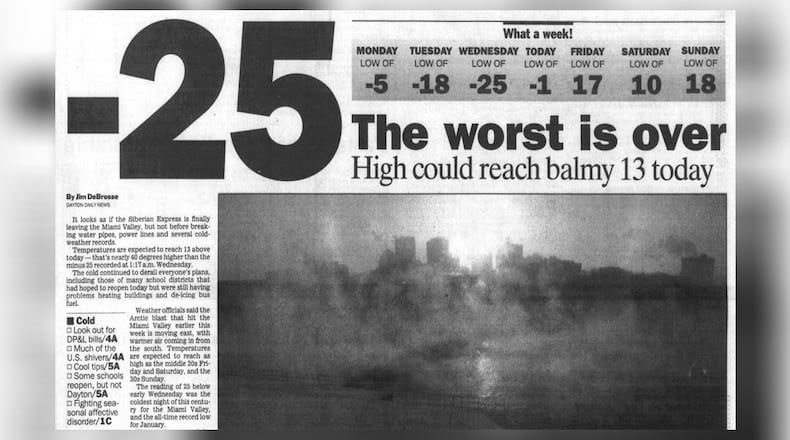The ‘Siberian Express’
The weather system that hit the Miami Valley in 1994 was known as The Siberian Express — a phenomenon where Arctic air perches atop the Midwest instead of the polar ice cap. This happens when the jet stream dives south towards Florida, pulling Arctic air along behind it. Each time it forms, it brings sub-zero temperatures into the region.
Its effects were clear: Wind chills that brought frostbite within minutes and a cold so severe it rendered road salt useless.
Sunday morning, the temperatures dropped to minus-11 with 10 to 20 mph winds.
It snowed 9.3 inches overnight Sunday into Monday. The heavy snow caused homeless shelters to be packed with people and libraries and stores to shut down. Monday’s high temperature was zero degrees. The high on Tuesday was minus-4.
By Wednesday, low temperatures hit minus-25 overnight, derailing the previous daily record of minus-14, set in 1977. Gusting winds drove the wind chill to minus-58.
The reading of -25 was the coldest of the century for the Miami Valley, and the all-time low for January.
Roads covered
The snow started falling in Dayton “right around the dinner hour Sunday.” Because of the early warning from the weather service, many local and highway crews had time to get their snowplows ready, but the challenges they would face were tougher than expected.
Within hours, roads in the Miami Valley turned slippery and police agencies throughout the area were reporting dangerous conditions. Shortly after 8 p.m., the Montgomery County Sheriff’s Office placed its deputies on “stationary patrol,” ordering them to respond just to emergency situations because of deteriorating road conditions.
Riverside police and Madison and Jefferson Twp. officers also were ordered to limit patrols and seek shelter if needed. Darke and Preble counties were reporting cars off the roads and into ditches.
Snow removal emergencies were declared in downtown Dayton, downtown Xenia, Miamisburg, New Carlisle and Madison Twp. Sheriff’s departments in Clinton and Butler counties also declared snow emergencies on Monday.
Snowplow drivers were having to stop and scrape off their windows. Their defrosters were not keeping the ice off. Snow was also blowing across the roads as fast as they plowed it.
Crews stayed busy on the major thoroughfares, which meant many residential streets didn’t get immediate attention.
By Tuesday, the slush on the roads froze and road salt was useless. Interstate 75 near downtown Dayton was closed for about an hour Tuesday night due to ice.
Later in the week, snow was so deep that Dayton’s public works department couldn’t just plow downtown streets — workers had to use front-end loaders to shovel the snow into trucks and dump it at Triangle Park lot.
By Thursday the worst was over. The Arctic blast was headed off to the east and temperatures went back to a normal range, 40 degrees warmer.
Marchers braved the elements
Even a snow emergency in downtown Dayton couldn’t halt the annual Martin Luther King Jr. parade that Monday. About 500 people bundled up for the three-and-a-half mile trek from Westown Shopping Center to Courthouse Square, where they then held a rally.
In Greene County, the annual four-mile march from Central State University to honor King was canceled. Roads were too snow-covered and treacherous for police to control traffic and ensure safety.
Schools closed
Schools and daycare centers were off for the Martin Luther King Jr. holiday on Monday, and most decided early to also be closed on Tuesday.
Dayton public schools stayed closed until Monday, in part because Friday was scheduled as a teacher’s record-keeping day. The teachers were told to just stay home instead of coming in.
About the Author






